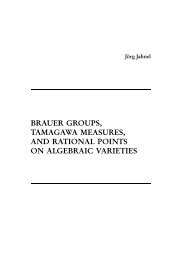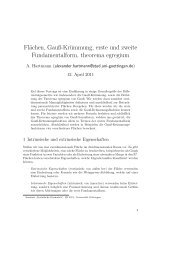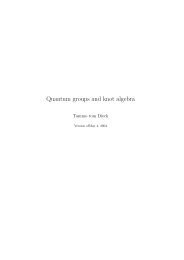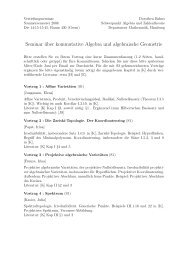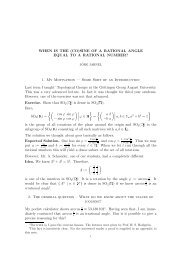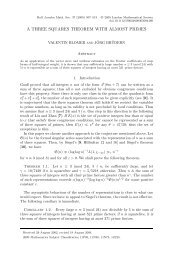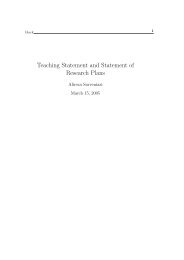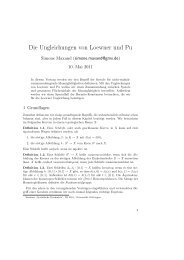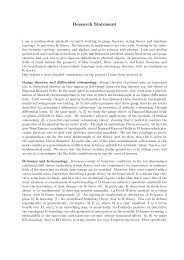The Picard group of a K3 surface and its reduction modulo p
The Picard group of a K3 surface and its reduction modulo p
The Picard group of a K3 surface and its reduction modulo p
You also want an ePaper? Increase the reach of your titles
YUMPU automatically turns print PDFs into web optimized ePapers that Google loves.
2.3. Lemma. –––– Let p ≠ 2 be a prime number <strong>and</strong> X ap-scheme which is<br />
Noetherian <strong>and</strong> separated. Denote by P ⊆ Pic(X p ) the subset <strong>of</strong> all invertible sheaves<br />
allowing a lift as an invertible sheaf on ̂X.<br />
<strong>The</strong>n, Pic(X p )/P is torsion-free.<br />
Pro<strong>of</strong>. First step: Preliminaries.<br />
Assume, to the contrary, that Pic(X p )/P has torsion. <strong>The</strong>n, there are a prime<br />
number l <strong>and</strong> an invertible sheaf L ∈ Pic(X p )\P such that L ⊗l ∈ P. This means<br />
that L ⊗l lifts to ̂X but L does not.<br />
By [Ha, Proposition II.9.6], an invertible sheaf on ̂X is the same as an inverse<br />
system (L n ) n <strong>of</strong> invertible sheaves L n ∈ Pic(X p n) such that L n+1 | Xp n = L n for<br />
all n. Hence, we have an invertible sheaf L n ∈ Pic(X p n) not lifting to X p n+1 but<br />
such that Ln ⊗l lifts to X p N for any N.<br />
Second step: Obstructions.<br />
In the short exact sequence<br />
0 −→ K −→ O ∗ X p n+1 −→ O ∗ X p n<br />
−→ 0 ,<br />
we have O Xp<br />
∼ = K via the exponential map x ↦→ 1 + p n x (mod p n+1 ). Thus, there<br />
is the exact cohomology sequence<br />
H 1 (X p , O Xp ) −→ Pic(X p n+1) −→ Pic(X p n) −→ H 2 (X p , O Xp ) .<br />
As L n does not lift to X p n+1, it defines a non-zero class cl(L n ) ∈ H 2 (X p , O Xp ).<br />
This is a p-torsion <strong>group</strong> as the sheaf O Xp is annihilated by p. Hence,<br />
cl(L ⊗l<br />
n ) = l·cl(L n ) ≠ 0<br />
for l ≠ p. This means that Ln<br />
⊗l does not lift to X p n+1, either, which is a contradiction.<br />
For l ≠ p, the pro<strong>of</strong> is complete.<br />
Third step: <strong>The</strong> case l = p.<br />
Here, we have to describe the obstruction more concretely. Let (U i ) i be an open<br />
cover <strong>of</strong> X p which trivializes the sheaf L n . Choose isomorphisms L n | Ui<br />
∼ = OXp n | Ui .<br />
<strong>The</strong>n, L n is described by transition functions g ij ∈ O Xp n(U i ∩ U j ) fulfilling<br />
g ij g jk = g ik on the triple intersections. <strong>The</strong> class cl(L n ) is given by the cocycle<br />
(c ijk ) ijk such that<br />
˜g ij˜g jk˜g −1<br />
ik = 1 + pn c ijk (mod p n+1 )<br />
for ˜g lm a lift <strong>of</strong> g lm to O Xp n+1.<br />
For Ln<br />
⊗p , the transition functions are g p ij . Further, there is the congruence<br />
p<br />
˜g ij˜gp<br />
jk˜g−p<br />
ik = 1 + pn+1 c ijk (mod p n+2 )<br />
which, as p > 2, is valid for every n ≥ 1. By assumption, Ln<br />
⊗p lifts to X p n+2.<br />
Hence, (c ijk ) ijk defines the zero class in H 2 (X p , O Xp ). But then, L n lifts to X p n+1,<br />
a contradiction.<br />
□<br />
4



